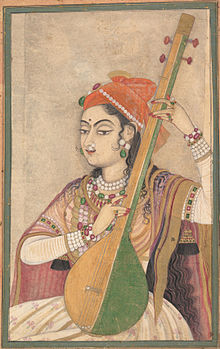Music of Arunachal Pradesh
| Music of India | |
|---|---|

A Lady Playing the Tanpura, ca. 1735 (Rajasthan)
|
|
| Genres | |
|
|
| Media and performance | |
| Music awards | |
| Music festivals | |
| Music media | |
| Nationalistic and patriotic songs | |
| National anthem | Jana Gana Mana |
| Regional music | |
|
|
Arunachal Pradesh is a state of India. It is known for dance music, which comes in many different styles. Dances from the region are often ritual in nature, but are also celebratory. They are mostly group dances, though others are restricted to men. Dances include popir, ponung and pasi kongki (of the Adi), rekham pada (of the Nishing), aji lhamu (of the Monpa) and hiirii khaniing (of the Apatani).
The Idu Mishmis have a ritual dance and a fertility dance. The ritual dance is performed by the priest or priestess in the ceremonies of Ai-ah, Ai-him, Mesalah and Rren. The fertility dance is performed on the last day of the Rren ceremony.
There is no definite myth about the origin of this ritual dance. According to local tradition, the first priest who officiated in a funeral ceremony was Chineuhu and his brother Ahihiuh, was the first priest who officiated in the other three ceremonies in which this dance forms a part. This dance is associated with the priestly office.
Besides the priest, there are three or four other dancers who are selected from amongst the spectators. In addition, it is the usual dress which consists of a loin-cloth, a short-sleeved coat, and a sword slung on the right side, a leather bag slung on the left side and a few bead-necklaces, the priest wears a few other articles. These articles are an apron with particular designs, a head-band decorated with two or three rows of cowries, a necklace studded with the teeth of tiger and bear and a few metal bells. A priestess wears these special articles in addition to the usual Mishmi woman's dress of a skirt, a long-sleeved coat and bead-necklaces. The priestess is generally accompanied by female dancers. The accompanying dancers wear the usual dress.
The dancers stand in a line, the priest is second either from the right or left. During the dance, one dancer standing at one end of the line plays a small drum slung from his neck. The priest and the other two dancers play a very small semi-globular single-membrane drum, striking it with a bamboo-stick which is kept tied to the drum with a string. The fifth dancer, if any, plays a horn bugle. When there are five dancers, the priest stands in the middle of the line. He sings a line of invocatory song while all the others play the musical instruments, flex the knees bobbing up and down and alternately raise the right and left heels and stamp these on the ground in time to the drum-beats. When the priest finishes singing the line, others repeat it in chorus. Again the priest sings another line of the song which the others repeat in chorus and thus it goes on.
...
Wikipedia
